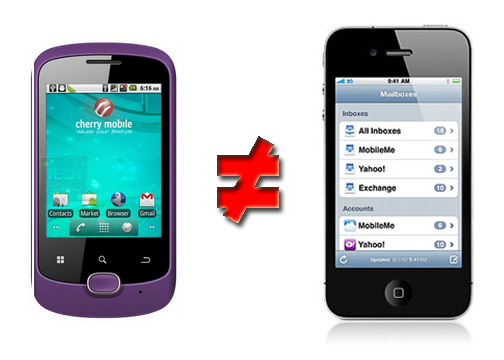
If you’re a student and have been considering buying a touchscreen smartphone but still find Php5k to be too much for your budget, you’ve probably been tempted by some of the budget Android handsets that Cherry Mobile and Torque have come out with. I’ve even seen some of the cheap Android phones that have been imported from China on sites like Sulit.com.ph and Ayosdito.ph.
Touchscreens aren’t all made alike though. If you think the screen on a Cherry Mobile Candy that you got for Php2.6k is just as good as your rich friend’s iPhone, you would be mistaken. And you only have to have one big reason to skip on any so-called smartphone that sells for less than Php5k
What are Capacitive and Resistive Touchscreens?
It all has to do with the touchscreen technology being used. There are actually two types of touchscreens that can be found on mobile devices out there: Capacitive and Resistive. The Resistive touchscreen is an older technology that registers presses based on where you apply pressure on the screen and they work great with a stylus. A Capacitive touchscreen is different because it only needs your finger to come in contact with the screen’s surface for it to register a touch. No added pressure necessary. However, an ordinary stylus won’t work with a capacitive screen because it doesn’t conduct electricity, unlike the human body. The same thing goes with gloves. Because gloves are typically made of electrically insulating material, your touches simply won’t be registered.
How This Affects Real World Usage
Part of the reason an iPhone or iPod Touch feels buttery smooth when navigating through the menus has to do with the screen. You barely have to press on the screen at all. A light press or swipe is enough to quickly glide through the menus and access what you want. Obviously, they feature capacitive screens.
Resistive screens can vary in terms of how sensitive they are to pressure. For example, my old Samsung Star was quite responsive and only needed light pressure for it to register my keypresses. On the other hand, I also have a Coby Kyros MID7015. It’s a 7″ Android tablet with a resistive screen. My presses barely registered even when I applied more pressure. It’s a good thing I only used it for reading eBooks and comics. Still, even the most responsive Resistive touchscreens like that on my trusty Samsung Star tend to make your fingers hurt faster than Capacitive screens do after using them for a while.
Also, Resistive screens come with a bit of flex to them. Since you have to apply pressure for them to register anything, the screen has to bend a bit. That means the screen tends to be less durable and more prone to scratching. A Capacitive screen doesn’t have to flex, so manufacturers can make the glass more resistant to breaking. You can see this on the break-resistant glass used on the iPhone 4 and 4S, as well as Android phones and tablets that use Corning’s Gorilla Glass or some other unbranded version. To illustrate this difference, the unprotected screen on my Coby Kyros already has a hairline scratch, despite being used with a case. On the other hand, I would put my Galaxy Note in a pocket with my keys and coins and it came away unscratched until I decided to finally invest in a good screen protector on it. Take note that budget smartphones like the Galaxy Y that feature capacitive screens aren’t likely to make use of more break-resistant glass, but they are still generally more durable than resistive screens.
Conclusion
Simply put, Resistive touchscreens are a pain in the neck. Yet the reason they are still finding themselves on cheap phones is because they are cheaper to manufacture than Capacitive screens. Php5k isn’t much these days, and if you want a decent touchscreen phone that is as responsive to touch as an iPhone, it’s best to save so you can get a decent phone with a Capacitive screen. Your fingers will thank me when you do.



7 thoughts on “Why You Shouldn’t Consider Buying a Touchscreen Smartphone for Less Than Php5k”